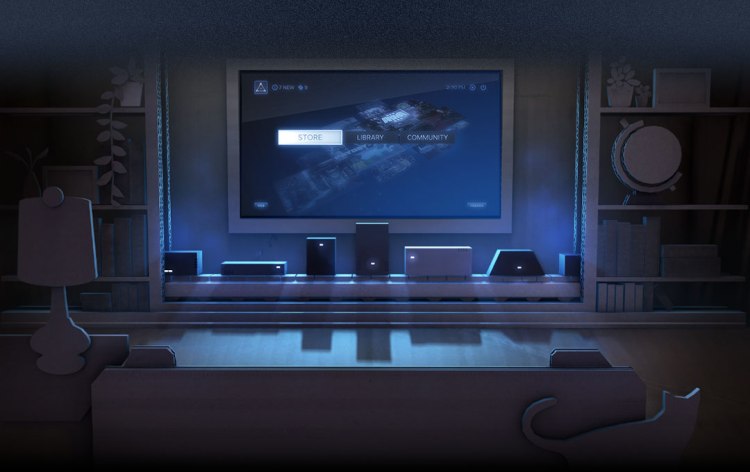This post has not been edited by the GamesBeat staff. Opinions by GamesBeat community writers do not necessarily reflect those of the staff.
In one week, Valve has changed the gaming landscape for the next generation. Before now, everyone was focused on the Xbox One and PlayStation 4 launches, with the Wii U’s exclusives giving it some exciting titles whenever they’re released. Valve has shaken things up by announcing not only its own operating system but also hardware that will make use of it.
Given that the company has run its own online storefront for years and more recently introduced Big Picture mode for TV-friendly gameplay, these announcements shouldn’t have come as too big a surprise. Valve has slowly been conditioning users to see Steam as a viable primary gaming platform — now the plans are just becoming more concrete.
The SteamOS announcement created some confusion over how it would run on machines in the living room, a statement that now makes sense with the reveal of Steam Machines. These presumably high-powered devices have been crafted to bridge the gap between PC and console gaming and completely remove physical media from gaming. While mobile and Ouya gamers may be used to this idea, longtime console owners may have a hard time buying games without having something tangible to show for it. That uneasy feeling will likely disappear completely when they experience a Steam sale and find that they can get the same basic game for pennies on the dollar compared to its packaged cousin.
The timing of the release is just about perfect. In 2014, many people will be aware of new console hardware but unwilling to spend $400 for a PS4 or $500 for an Xbox One. This will be especially true of players who don’t solely buy the latest games but want older fare as well. “Older” is a relative term here since it’s hard to quantify something that is 6 months old as obsolete even in today’s technology market. If Valve is able to release a Steam Machine in the $500 range and make sure that people know it can not only play Xbox 360 and PlayStation 3-age titles but also be future-proofed enough to handle Xbox One and PS4 games, then it’ll be in a very advantageous position.
Exclusives are fewer in number now than they’ve ever been, and that means that owning every system is less necessary. With a few exceptions, most multiplatform games run about the same on each version of console hardware, with high-end PC versions generally being the best ones to buy if your setup is powerful enough. In theory, with a Steam Machine, you’ll be able to play the best versions of games, and as a nice bonus, generally save at least $10 on each purchase right away since PC titles tend to sell for $10 less on launch. If you buy a lot of games on day one, you could easily save $500 over the course of a year.
Both the Xbox One and PS4 have interesting exclusives, but will they be worth paying the console’s asking price in order to play? Unless you’ve tackled every challenge in Forza 4 and Horizon, $500’s a bit much to spend on an Xbox One. Are Dead Rising 3, Ryse, Crimson Dragon, and Killer Instinct enough to make people want the system ASAP? Killzone: Shadowfall looks like the greatest entry in the series yet, but is it worth buying a console for if you’re not a huge fan? Infamous: Second Son stands a greater chance of being a system-seller but could be greatly hurt by people still enjoying Grand Theft Auto V — especially with GTA Online in October set to greatly expand the replay value far beyond its single-player story.
Right now, the biggest challenges facing the Steam Machine are its many unknowns. We don’t know any specs at the moment. One would presume it would have USB support for a 360 pad and later PS4 and Xbox One controllers as well. The upcoming public beta of the hardware should give us an idea of just how bad things could be if they go wrong and how good they could be if they don’t.
One would also hope that Valve sticks to a single design for the OS — comparing it to the UI on the Xbox 360 and PS3, constant change is rarely good. Sony was smart to keep things the same for as long as it did while Microsoft has tinked with the 360’s dashboard so much that it doesn’t even resemble its original incarnation. The Big Picture mode is simple. Everything is easy to find, and you aren’t left with a feeling of confusion when you try to find a game or browse the web. Even that functionality works well, and the emphasis on efficient onscreen typing via the controller makes even more sense now than it did before since Steam will be used in the living room.
The idea of basically streamlining a top-tier PC for gaming purposes and bringing it to the mass market is an exciting one, and it will be the closest thing to a game-changer the industry has seen in a while. Steam Machines have far more potential to be not only the primary household gaming device but also the primary multimedia device — and for many, it could be a godsend if they’re looking to keep up with video games without breaking the bank on a high-end PC.


